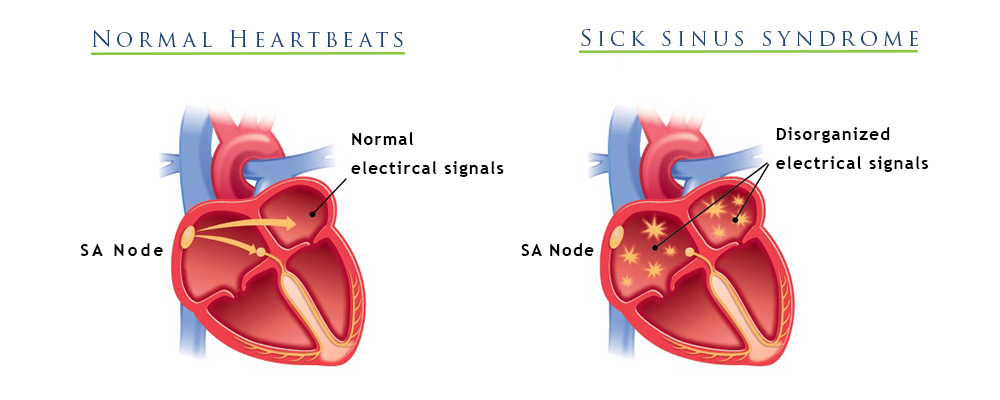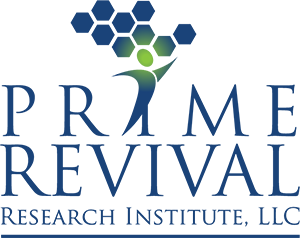Last Updated on March 24, 2023
Introduction:
Sick sinus syndrome also known as sinus node dysfunction—is a term used to describe a number of different abnormalities in the heart rhythm (known as arrhythmias). The arrhythmias associated with this syndrome, typically involve persistent bradycardia with intermittent tachyarrhythmias. It primarily affects the elderly. While there are many possible causes, it is usually idiopathic. It is frequently asymptomatic or has nonspecific or subtle symptoms.
Sick sinus syndrome is challenging to diagnose due to its nonspecific symptoms and enigmatic electrocardiogram findings. The mainstay of treatment is to provide adequate symptom relief while decreasing the incidence of atrial fibrillation, thromboembolic events, heart failure, and mortality.
Understanding what is Sick Sinus Syndrome
The heart is composed of four chambers – two atria located at the upper portion and two ventricles located at the lower portion. The sinus node, which is found in the right atrium, is the natural pacemaker and produces electrical signals to control the heart rate. These signals travel through the atria and into the ventricles, prompting them to contract and pump blood to the lungs and body.
Sick Sinus Syndrome (SSS) is a condition in which the heart’s natural pacemaker, located in the right atrium, is impaired and is unable to generate regular electrical signals. This may be a consequence of other medical issues that gradually damage the sinoatrial node (SA node) or from particular medications. This can lead to heartbeats that are either too slow, too fast or that switch between slow and fast. While it is relatively uncommon, the risk of developing the syndrome increases with age.

Bradycardia-tachycardia syndrome, sinus node dysfunction, slow heart rate – sick sinus, tachy-brady syndrome, sinus pause – sick sinus, and sinus arrest – sick sinus are all alternative names for this syndrome.
Types of Sick Sinus Syndrome
When the sinus node fails to function properly, a variety of disorders develop. The resulting heartbeat or rhythm will differ depending on the specific electrical activity at the sinus node.
Sinus sick syndrome is defined by the following disorders:
- Sinus bradycardia: The heart beats very slowly which is less than 60 beats per minute.
- Sinus arrest or sinus pause: The sinus node temporarily stops working or pauses, causing a change in the heart’s beating.
- Sinoatrial block: The sinus node impulse is prevented from reaching the atria, the two upper chambers of the heart.
- Tachycardia-bradycardia (or tachy-brady) syndrome: This is when the heart alternates between very slow and very fast beats.
Sick Sinus Syndrome Causes
Any condition that can lead to cardiac damage can affect the SA node as well. Causes include:
- Age-related wear and tear of heart tissues
- Damage to the sinus node or scarring due to any heart surgery
- Heart diseases
- Inflammatory diseases
- Medications to treat high blood pressure or arrhythmias
- Alzheimer’s disease medications
- Neuromuscular diseases
- Obstructive sleep apnea
- Rare genetic changes
Sick Sinus Syndrome Symptoms
Patients dealing with sinus syndrome may be asymptomatic or have mild and non-specific symptoms. These include:
- Fluttering heartbeats (palpitations)
- Pain or discomfort in the chest
- Confusion
- Feeling dizzy or lightheaded
- Fainting
- Fatigue
- Breathing difficulty
- Slower heart rate (bradycardia)
These symptoms are associated with reduced cardiac output from bradyarrhythmias or tachyarrhythmias, which can lead to decreased cerebral perfusion and cause syncope or pre-syncope.
Sick Sinus Syndrome Risk Factors
As individuals advance in age, they become more susceptible to developing sick sinus syndrome. Congenital sick sinus syndrome refers to having the disease at birth. Congenital heart defects are the leading cause in both children and adults.
The following are risk factors:
- History of congenital heart disease (even with repairs, the heart is still weak)
- History of thyroid disease
- Sleep apnea disorder
- A clogged coronary artery limits blood flow to the heart
- Older age
Sick Sinus Syndrome Diagnosis
The physician or cardiologist may suspect this condition based on the symptoms, however, these symptoms are common in many other diseases. To be certain, an electrocardiogram (ECG) will be conducted to record the heart’s rate and rhythm. If there are not any symptoms at the time of the ECG, it may appear normal.
Other possible tests are:
- An electrocardiogram (ECG or EKG) is a test that records the electrical activity of the heart at that precise moment.
- An echocardiogram is a type of ultrasonic imaging of the heart.
- A transesophageal echocardiogram (TEE) is a test that involves inserting a special ultrasound device down the patient’s throat and into the esophagus to obtain a clear image of the heart’s size, contracting strength, and any damage to the heart muscle.
- A Holter monitoring test involves attaching an electrocardiogram monitor to the chest and wearing it for at least one 24-hour period. While wearing the monitor, the patient keeps a diary of his or her activities and symptoms.
Treatment of Sick Sinus Syndrome
The goals of sick sinus treatment are to reduce or eliminate symptoms while also managing any other contributing health conditions. Treatment options may include:
- Regular examinations
- Medications
- Catheter procedures
- Surgery to implant a device to keep a regular heartbeat (pacemaker)
If a patient does not have any symptoms, the doctor may simply recommend regular health checkups to monitor the condition. Most people who have symptoms require a procedure to implant a device to keep their heartbeat regular (pacemaker).
Medications:
Certain medications, such as those used to treat high blood pressure or heart disease, may impair sinus node function. Your doctor will most likely review your medications and may adjust them or prescribe different ones. Medication may be required to prevent or slow rapid heartbeats.
If atrial fibrillation or other irregular heart rhythms associated with stroke are present, blood thinners such as warfarin (Jantoven) or dabigatran (Pradaxa) may be prescribed as part of a treatment plan for sick sinus syndrome.
Surgical Procedures:
The majority of people with sick sinus syndrome will eventually require a permanent device to control their heart rhythm (pacemaker). A pacemaker is a small, battery-powered device that is surgically implanted under the skin near the collarbone. The pacemaker stimulates (paces) the heart as needed to maintain a regular heartbeat.
If the symptoms are mild or infrequent, the decision to use a pacemaker will be based on the results of electrocardiograms (ECGs), your overall health, and the risk of more serious problems.
The type of pacemaker required is determined by the irregular heart rhythm. Pacemakers are classified as follows:
- Single chamber pacemaker: This type typically transports electrical signals to the heart’s right lower heart chamber (ventricle).
- Double chamber pacemaker: This pacemaker separates the right lower heart chamber (ventricle) and the right upper heart chamber (atrium). Dual-chamber pacemakers benefit the majority of people with sick sinus syndrome.
- Biventricular pacemaker: Biventricular pacing, also known as cardiac resynchronization therapy, is used to treat people who have heart failure and irregular heartbeats. This pacemaker stimulates both lower heart chambers (the right and left ventricles) to increase the heart’s efficiency.
If the heart rate still remains irregular after getting a pacemaker, the patient may require medications or a catheter-based procedure known as cardiac ablation to correct or control it. Cardiac ablation is a procedure that uses heat or cold energy to create tiny scars in the heart in order to block faulty signals and restore a regular heartbeat.
Outlook
Sick sinus syndrome is a type of heart rhythm disorder. It has an effect on the heart’s natural pacemaker (sinus node), which controls the heartbeat. The risk of developing this condition rises with age. This syndrome causes slow heartbeats, pauses (long periods between heartbeats), or irregular heartbeats (arrhythmias).
Sick sinus syndrome is uncommon, but it is usually progressive, meaning it worsens over time. Many people with sick sinus syndrome require an implanted device called a pacemaker to keep their hearts in a regular rhythm. Pacemakers replace the missing electrical impulses from a faulty sinus node. Although pacemakers are not a cure, they are a very effective treatment.

